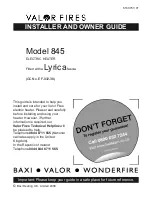
21
INSTALLATION
It is a requirement that only qualified and competent
personnel may undertake installation commissioning
and servicing of Heaters.
WARNING
All of the basic criteria must be satisfied prior to
commencing installation and commissioning,
additionally, the Unit Heater must be positioned and
installed so as to comply with all the relevant standards
and guide lines as well as meeting national and local
fire regulations and insurance criteria, especially if it is
proposed that the heater is to be installed within a
special risk area (e.g. proximity to where petrol engined
vehicles are stored or parked, where cellulose spraying
takes place, where woodworking machinery is
operated, etc,).
Indirect fired heaters
must not
be located in hazardous
areas. However, it is permissible for the heater to
supply air to such areas. The heater
must not
be
installed within an environment where there is a high
concentration of chlorides, fluorides, salts, or other
aggressive or volatile chemicals/compounds.
Nor should the heater be positioned where the burner
could be adversely affected by high winds or draughts.
The heater must be installed so that it is level. Supports
for the heater must be sufficiently robust to withstand
the weight of the heater and any ancillary equipment.
Any combustible material adjacent to the heater or flue
system must be so placed or shielded so that its
surface temperature does not exceed 65ºC
The location chosen for the heater must allow for
the fitting of an effective flue system.
The heater must be installed so that it is level, supports
for the heater must be sufficiently robust to withstand
the weight of the heater and any ancillary equipment
Any combustible material adjacent to the heater or flue
system must be so placed or shielded so that its
surface temperature does not exceed 65
o
C. Generally a
free blowing heater should be located at a height
(measured from floor level to the base of unit)
The location chosen for the air heater must allow for the
fitting of an effective flue system. It must also allow
adequate clearance for the air supply, return air
circulation, gas supply, electrical supply and also
provide good service access.
Suspended free blowing Unit Heaters are at their most
effective when located as close to the working area as
possible. However care should be exercised to avoid
directing the discharged air directly onto the occupants
of the area to be heated.
Where the passage of cold air causes problems (eg by
entrances, loading bays etc) it is considered favourable
if the heater is positioned so as the discharge towards
or across the cold air source from a distance from 1.5 m
- 6m dependent upon the size of the entrance and the
air throw characteristics of the heater. On exposed
walls heaters should be positioned so as to discharge
towards, or along the length of the exposed wall.
Where the passage of cold air causes problems (eg by
entrances, loading bays etc) it is considered favourable
if the heater is positioned so as the discharge towards
or across the cold air source from a distance from 1.5m
- 6m dependent upon the size of the entrance and the
air throw characteristics of the heater. On exposed
walls heaters should be positioned so as to discharge
towards, or along the length of the exposed wall.
CAUTION
Ensure that the gas service to the appliance carries the
correct gas type and that the supply pressure is in
accordance with the supply type and pressure stated on
the appliance data plate.
Installation, commissioning, and servicing must only be
carried out by appropriately qualified and competent
persons.
WARNING
Unauthorised modifications to the appliance, or
departure from the manufacturers guidance on
intended use, or, installation contrary to the
manufacturers recommendations may constitute a
hazard.
NOTE
To ignore the
warning
and
caution
notices, and to
ignore the advice from the manufacturer on installation,
commissioning, servicing, or use, will jeopardise any
applicable warranty, moreover, such a situation could
also compromise the safe and efficient running of the
appliance itself, and thereby constitute a hazard.
The installation of the appliance must meet all the
relevant European, National, and local criteria. Prior to
installation the following points should be considered:
a) The position of the heater for the optimum efficient
distribution and circulation of warm air
b) The position of the heater relative to the route of the
flue
c) The position of the heater relative to the supply of
gas
d) The position of the heater relative to the electrical
services, wiring routes, and if appropriate, any
additional controls.
e) The position of the heater relative to the supply of
fresh air
f) The position of the heater relative to potential
stratification / circulation problems, which generally
occur at higher levels and which may be overcome
through the provision of a suitable de-stratification
unit.
g) The position of the heater relative to service and
maintenance requirements
CAUTION
The heater
must not
be installed within an area where
the conditions are unsuitable, e.g. where the
atmosphere is highly corrosive, has a high degree of
salinity, or where high wind velocities may affect burner
operation. Suitable protection should be provided for
the appliance when it is located in a position where it
may be susceptible to external mechanical damage
from; for example, fork lift trucks, overhead cranes etc.
















































